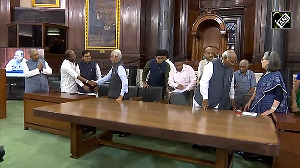Red Bull, the team owned by the Austrian energy drinks manufacturer whose product is not sold in France because of the high caffeine content, summed up their feelings about travelling to the geographical heart of the country in a flippant race preview two years ago.
"The nearest town to the circuit is Nevers and if you pronounce it the right way, it perfectly describes how many times people want to come back," it declared.
The circuit, it added, was "a great place if you like to look at cows".
Even that could soon be no longer an option after the French motorsport federation's (FFSA) announcement on Thursday that it had decided to "suspend the inscription" of next year's race because of logistical problems.
The FFSA hoped for France, birthplace of the sport, to return to the calendar in 2009 -- but not necessarily at Magny-Cours.
The trend now is for street circuits and races near the major population centres, with a grand prix on the outskirts of Paris a far more attractive proposition for those pumping money into the sport.
Magny-Cours, surrounded by pastures and cornfields, will never match the bright lights and sophistication of the metropolis.
"For me, a Paris GP has been a dream dating back several years," Formula One supremo Bernie Ecclestone told France's Auto-Hebdo magazine recently.
RURAL CHARM
Like the now-vanished Austrian Grand Prix or Imola in Italy, Magny-Cours possesses a rural charm of a kind that is fast vanishing from a sport rushing full tilt into new markets in the Middle East and Asia.
There may not be any nightclubs, and few restaurants and hotels either, but there are compensations -- the sun usually shines, there are some fine vineyards nearby and one can see the stars at night.
But that hardly adds up to a major selling point for the corporate crowd.
Despite ever more inventive attempts to bring in the spectators, too few -- in a country currently without any drivers on the starting grid -- want to head out to the countryside to watch the race.
Where Monaco acts like a magnet to the beautiful people, flaunting their wealth in a Mediterranean millionaires' playground, Magny-Cours brings out the boy scouts and the campers.
The future would seem to be elsewhere. Rural circuits like Magny-Cours, Silverstone, Spa-Francorchamps and the Nuerburgring are now in a minority and more threatened than ever.
"There's a country I've been told is Third World called Turkey," Ecclestone, who would like to see a calendar of 20 races rather than the current 17, told the Mail on Sunday earlier this month.
"People should take a look at their circuit and compare them to Silverstone.
"We don't want to lose the French Grand Prix," he added at the same time. "But it's a circuit like Silverstone. The French federation told me once that they'd more or less build a six-lane highway from virtually the Place de la Concorde in Paris straight to the circuit. It never happened." Fuji, this year's newcomer to the calendar, may be in a protected area of natural beauty but it also has 63 percent of Japan's population, equivalent to 80 million people, living within 300km.
If Magny-Cours is indeed absent next year, there will be no problem in filling the space.
Valencia, with double world champion Fernando Alonso sure to bring in a huge crowd in his native Spain, is lobbying hard for a street race.
Singapore, in talks with Ecclestone for a night race, would also be a frontrunner for a 2008 debut.
Then there is Abu Dhabi, with its Monaco-like waterfront circuit confirmed for 2009, and South Korea with an agreement for a race in 2010.
India, Russia, South Africa and Japan's Suzuka are among the other serious candidates along with a possible second race in the United States.
The days when you could leave a circuit at the end of the day and see cows grazing in surrounding fields will soon be nothing more than a memory, fond or otherwise.







